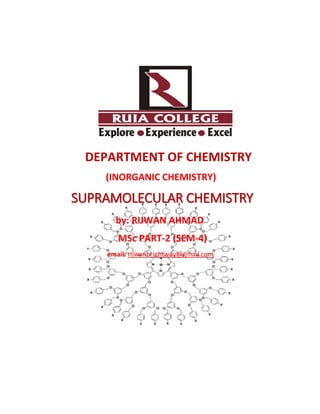
Supramolecular Chemistry (by- Rijwan Ahmad)
- 1. DEPARTMENT OF CHEMISTRY (INORGANIC CHEMISTRY) SUPRAMOLECULAR CHEMISTRY by: RIJWAN AHMAD MSc PART-2 (SEM-4) email: rijwanbrightway@gmail.com
- 2. INTRODUCTION: Supramolecular chemistry, a term introduced by Jean Marie Lehn, is “chemistry beyond the molecule”, i.e. the chemistry of molecular assemblies using noncovalent bonds. Supramolecular chemistry is one of the new areas of chemistry which deals with secondary interactions rather than covalent bonds in molecules and focuses on the chemical systems made up of a discrete number of assembled molecular subunits or components. The forces responsible for the spatial organization may vary from weak intermolecular forces to strong covalent bonding, The weak intermolecular forces are hydrogen bonding, metal coordination, hydrophobic forces, van der Waals forces, pi-pi interactions and electrostatic effects. The use of these principles led to the better understanding of protein structure as well as other biological processes. For instance, elucidation of the double helical structure of DNA (by Watson and Crick) occurred when it was realized that there are two separate strands of nucleotides connected through hydrogen bonds. The use of non-covalent bonds is essential to replication because they allow the strands to be separated and used to template new double stranded DNA. The importance of supramolecular chemistry was established by the research work of Nobel laureates Donald J. Cram, Jean-Marie Lehn, and Charles J. Pedersen in 1987 for Chemistry. The development of selective "host-guest" complexes particularly, in which a host molecule recognizes and selectively binds a certain guest, was cited as an important contribution. Supramolecular chemistry enriched by the research works of James Fraser Stoddart with the development of concepts of highly complex self assembled structures and molecular machinery. Again, Itamar Wilmer developed concepts of bio-sensors and methods of
- 3. electronic and biological interfacing. Simultaneous development of nanotechnology also had a strong influence on this subject, with building blocks such as fullerenes, nanoparticles, and dendrimers becoming involved in synthetic systems. The subject gradually develops by the research works on molecular self- assembly, folding molecular recognition, mechanically-interlocked, molecular architectures and dynamic covalent chemistry the study of non-covalent interactions is crucial to understanding many biological processes from cell structure to vision that rely on these forces for structure and function. Biological systems are often the best inspiration for researches in supramolecular chemistry.
- 4. HISTORY: In 1967, Pedersen observed that crown ether showed molecular recognition – the first artificial molecule found to do so. Cram established, host–guest chemistry, where the host molecule can accommodate another guest molecule. In 1978, Lehn proposed the term “supramolecular chemistry”. Together, Pedersen, Cram and Lehn received the Nobel Prize for Chemistry in 1987. The existence of intermolecular forces was first postulated by Johannes Did Erik van der Waals in 1873. Later in 1894, Nobel laureate Hermann Emil Fischer introduced the philosophical roots of supramolecular chemistry by suggesting "lock and key" mechanism for enzyme-substrate interactions, which is the fundamental principle of molecular recognition and host-guest‘ chemistry. In the early twentieth century non-covalent bonds were understood in gradually more detail, with the hydrogen bond being described by Latimer and Rodebush in 1920.
- 5. NATURE OF THE INTERMOLECULAR FORCES: Covalent bond Ion-ion interaction Ion-dipole interaction Dipole-dipole interaction Hydrogen bond Cation –n(π) interaction π-π interaction Van-der-Waals interaction Hydrophobic effects 200-300 kJ/mol 50-200 kJ/mol 5-50 kJ/mol 4-120 kJ/mol 5-80 kJ/mol 0-50 kJ/mol (<5 kJ/mol) Entropy
- 7. THE HIERARCHY OF STRUCTURAL ORGANIZATION OF MATTER: Supramolecular chemistry involves investigating molecular systems in which the most important feature is that components are held together by intermolecular forces, not by covalent bonds. Atoms Molecules Molecules Superamolecules
- 8. SUPRAMOLECULAR CHEMISTRY- IN NATURE: Multiple hydrogen bonds hold the DNA double helix together.
- 9. CLASSIFICATION OF SUPRAMOLECULES: Molecular recognition chemistry (host–guest chemistry) + chemistry of molecular assemblies + chemistry of molecular associations “supramolecular chemistry” chemistry of molecules built to specific shapes (Rotaxane, catenane, Dendrimers, Fullerene, CNTs..) molecular recognition chemistry: chemistry associated with a molecule recognizing a partner molecule (Crown ether, Polyamines, Cyclodextrin, calixarne..) chemistry of molecular assembly from numerous molecules (Amphiphilic molecules – micelles, lipids..)
- 10. MACHENISM: Supramolecular chemistry involves basically two types of mechanism or the combination of substrate and reactant, i.e. “lock & key” and Host-guest chemistry, which are as fallows, Lock and Key: Host-guest:
- 11. APPLICATIONS:
- 12. PHASE TRANSFER AGENTS: Separation of mixtures:
- 14. FLUORESCENT SENSOR: (Crown- anthracene system) Receptor (Host): crown ether, Substrate (Guest): K+ Signaling unit: anthracene, Spacer: –CH2- There are many more other applications of supramolecular chemistry, • molecular electronic devices • molecular photonic devices • molecular computer • molecular machines • Microscopes • Optical Microscope I. Scanning Electron Microscope (SEM) II. Transmission Electron Microscope (TEM) III. Scanning Tunneling Microscope (STM) etc.
- 15. REFERENCES: • SUPRAMOLECULAR CHEMISTRY Jonathan W. Steed & Jerry L. Atwood • SUPRAMOLECULAR CHEMISTRY, FUNDAMENTALS & APPLICATION Katsuhiko Ariga, Toyoki Kunitake • SUPRAMOLECULAR CHEMISTRY-CONCEPTS AND APPLICATIONS International Journal of Science and Research (IJSR); Paper ID: 29031502; Ajay Kumar Manna; Ramananda College, Department of Chemistry, Bishnupur, Bankura, West Bengal, 722122, INDIA. • SUPRAMOLECULAR CHEMISTRY - SCOPE AND PERSPECTIVES MOLECULES - SUPERMOLECULES MOLECULAR DEVICES Nobel lecture, December 8, 1987; by JEAN-MARIE LEHN; Institut Le Bel, Université Louis Pasteur, 4, rue Blaise Pascal, 67000 Strasbourg and Collège de France, 11 Place Marcelin Berthelot, 75005 Paris.
